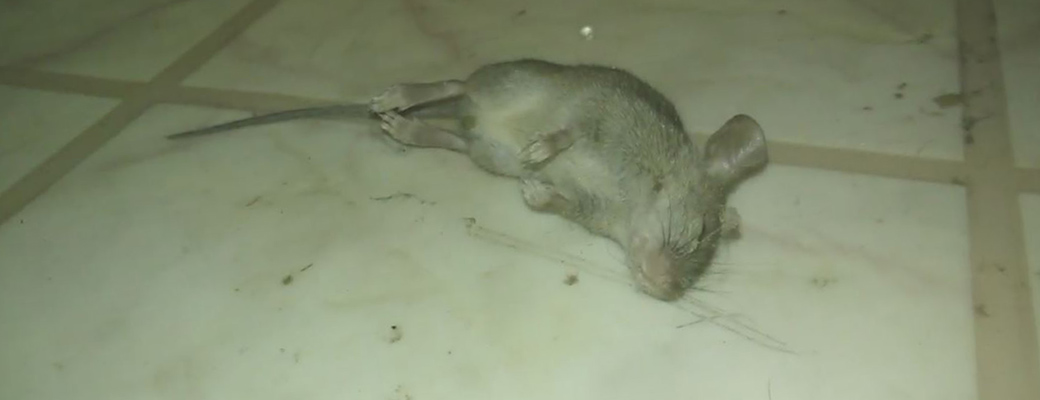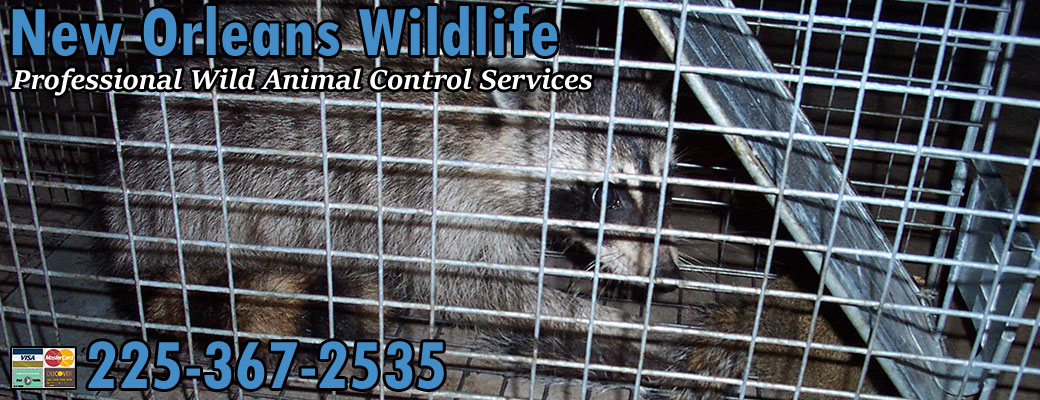Wildlife Exterminator New Orleans - 225-367-2535

Wildlife Trapping
When it's necessary to remove animals, we focus on humane and effective trapping and relocation.

Home Repairs
A critical step - the identification and repair of any and all wildlife entry points into the home.

Animals in Attic
We specialize in the removal of animals in the attic - squirrels, raccoons, rats, mice, bats, and more.

No Poisons!
We never use poisons in any part of our wildlife control, including rodent control. Poisons don't work!
We are New Orleans Wildlife, and we solve conflicts between people and wild animals. From squirrels in your attic, to raccoons in your trash, to bats, rats, birds, and snakes, we do it all. We specialize in safe and effective solutions to Louisiana critter problems. We service the greater New Orleans region, and we offer fast service - we can usually schedule a same-day appointment. Give us a call at 225-367-2535 any time, 24/7, and we will discuss your unique wild animal problem, and give you a free price quote over the phone. We're ready to take your call now!
Our service range: We service Jefferson Parish, Plaquemines Parish, St. Bernard Parish, St. Charles Parish, St. James Parish, St. John the Baptist Parish, St. Tammany Parish, Tangipahoe Parish, Washington Parish, and more. We also service Metairie, Chalmette, Kenner, LaPlace, Marrero, Slidell, Terrytown, Bogalusa, Destrehan, Estelle, Gretna, Hammond, Harvey, Jefferson, Luling, Mandeville, Maraux, River Ridge, Timberland, Westwego, Woodmere, and more.
New Orleans Wildlife Education: How To Know If You Have Rabies
If you have had any recent interactions with a wild animal, then you may be wondering if you have rabies. The good news is that it is incredibly rare for people to actually develop rabies. That being said, each year sees one or two deaths in the United States from the viral illness. This number is so small thanks to animal vaccinations and other measures.

Rabies Background
Rabies is caused by a virus that infects the brain and will eventually lead to death. When you are infected, the virus enters the subcutaneous tissue and muscle. There is a one to three month incubation period when the virus remains close to the site of exposure. After this, it travels through the peripheral nerves where it enters the brain then travels throughout the body.
Were You Exposed?
Before looking for symptoms of rabies, you need to think about whether you could have even been exposed to it. If you were bit by a rare rabid dog, then this is an obvious indication you may develop it. Other times, it isn’t so easy to figure out. Rabies is spread by saliva from an infected animal. In most cases, it is transmitted through a bite, but it can also happen if the animal’s saliva touches your mucous membranes or an open wound. Any type of mammal may spread rabies. The most common carriers within the United States are skunks, raccoons, foxes, coyotes, and bats. In developing countries, the most likely transmitters are stray dogs. Horses, cats, ferrets, and cows may also have the rabies virus.
Recognizing Early Symptoms
In some cases, people do not realize that they have rabies until they start to develop symptoms. The symptoms may start appearing within a week of infection but these early symptoms are typically general. They can include headaches, fever, and weakness. Because these symptoms can also be part of other illnesses, most people who haven’t been exposed to rabid animals won’t think twice about them.
Symptoms Based On Type Of Rabies
There are two types of rabies, paralytic and furious. Each type has a different set of symptoms that can indicate you probably have rabies. Paralytic rabies affects about 20 percent of the cases. This version involves the muscles slowly becoming paralyzed, typically beginning by the location of the bite. It eventually leads to a coma and then death.
The more common type of rabies is furious rabies. This accounts for 80 percent of cases and is the type of rabies most people are familiar with. It can include over-activity, anxiety, confusion, encephalitis (that leads to confusion, hallucinations, and/or a coma), hydrophobia (fear of water), hyper-salivation (overproduction of saliva), and difficulty swallowing. You don’t want to rely on the clinical symptoms of rabies to determine if you have it since once the symptoms have appeared, rabies is almost always fatal.
Confirmation Via Diagnosis
To definitely determine if you have rabies, your doctor will probably conduct multiple tests. These include skin samples, spinal fluid tests, blood samples, and saliva tests. The tests aim to detect proteins found on the surface of the virus, detecting the virus’s genetic material, or showing that you have an immune response to the virus.
Preventative Measures
They may begin by determining if you have a high risk following a bite by testing the animal that bit you for rabies. This requires euthanizing the animal and then examining the brain for the rabies virus. If the animal did have rabies, then your doctor will likely suggest a series of shots and treatments to prevent rabies from developing in you. In cases where the animal is a farm animal or pet and doesn’t show any symptoms of rabies, most experts suggest simply isolating it and observing the animal for 10 days, during which time symptoms should appear if it is infected.
Determining Treatment
If you are bitten by a potentially rabid animal, your doctor may suggest a series of shots that protect you from developing the illness. Any bite should be brought to your doctor’s attention as should saliva coming in contact with an open wound. If the animal that bit you was fully vaccinated, then you will probably not need treatment. There haven’t been any cases of rabies infection from a vaccinated domestic cat or dog in the United States. Most doctors will recommend beginning the series of shots if there is any chance you have rabies since the disease is fatal. If you may have rabies, your doctor will stop it from spreading in your body by giving you a rabies immune globulin shot that prevents infection. After that, you will receive four shots during two weeks. These rabies vaccines help your body fight the rabies virus.
Essentially, when it comes to rabies, you want to receive a diagnosis as soon as possible. If you suspect you may have been bitten by an infected animal or came in contact with its saliva, don’t wait for the symptoms appear. Instead, visit your doctor for a diagnosis right away so you can receive treatment before any symptoms appear.
Previous Education Articles
What to do about a wild New Orleans animal under the porch
The New Orleans Coral Snake
What should I do if I find an orphaned baby New Orleans opossum wandering about?
Why do New Orleans skunks dig?


